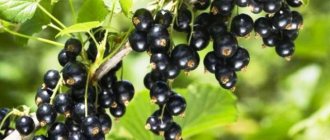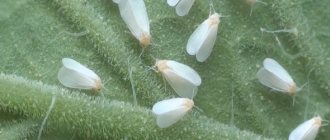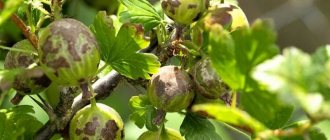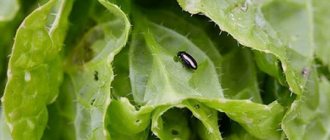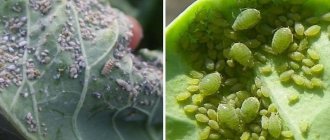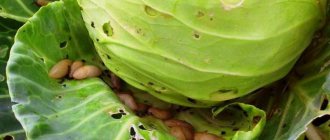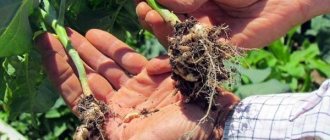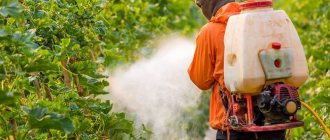It’s not just you who is laying claim to the beautiful cabbage sprawled freely in the garden bed. Various pests are lurking, waiting for the right moment to take over the harvest into which so much time and effort has been invested. The article will help you recognize enemies by sight from the photos provided and will tell you about methods of combating the main types of cabbage aggressors.
Cabbage aphid
One of the most voracious and widespread pests of cabbage. Adults are from 2 to 4 mm, greenish in color, covered with a waxy coating. Their main diet is cabbage juice. As a result of a mass meal, cabbage leaves curl and become discolored.
In mid-summer, winged aphids can be seen migrating to neighboring plants. By autumn, insects lay eggs on stalks and weeds. The eggs overwinter, and in the spring a new colony hatches - the cycle repeats.
Experienced gardeners recommend planting cabbage with the right neighbor, which will repel parasites. Dill or tomato are suitable for this protective role. Many summer residents prefer spraying with a vinegar solution (10 tsp 9% vinegar per 2 liters of water). The procedure is carried out late in the evening. Moisten the leaves generously, starting from the middle of the cabbage and moving towards the periphery.
If aphids are found despite preventive measures, then there is another proven folk method in stock. You will need:
- tar soap (20 g);
- laundry soap (20 g);
- ash (300 g per 10 liters of water).
The ash must be poured into a metal container and poured with boiling water (2.5 l). Mix thoroughly, cover and leave for 20 minutes. After this, the ash solution must be filtered and the volume brought to 10 liters. And then add both types of soap (pre-dissolve it in hot water). Now you can start spraying. Use a powerful jet to try to knock down the colony of parasites from the cabbage leaves. Sprinkle the top of the plant generously with dry ash.
Attention! Wood ash not only repels aphids, but is also an excellent fertilizer for cabbage.
Know how to safely treat cabbage against aphids
To destroy harmful insects in the garden, you can use various herbal infusions and wood ash. Such decoctions and infusions will be a good organic fertilizer for the crop during any growing season.
Solutions based on mustard powder, tobacco dust with the addition of soap are widely used by gardeners to combat not only aphids, but also other pests. Photo: sveklon.ru
An important point when destroying aphids on any crop is the fight against ants. Without removing breeders and defenders of the small pest from the site, treatment will not be effective. For this purpose, medications are used, for example, ammonia. It will also serve as a foliar fertilizer for cabbage.
Below are 15 recipes based on safe ingredients for killing cabbage aphids.
Cruciferous bug
The bug is small in size (5.5 - 8 mm) and variegated in color. The variable pattern consists of dark and colored (yellow, red) spots, dots and stripes. It feeds not only on cabbage, but also on other varieties of cruciferous crops.
Insects hibernate in gardens, nestling comfortably in fallen leaves near trees. In early spring, they settle on weeds, waiting for their favorite cruciferous plants to sprout. And after waiting, they arrange a noble “feast for the whole world.” They pierce the leaves with their proboscis and suck out the plant juice. The puncture sites become discolored, and if the damage is severe, the leaves turn yellow and subsequently die. 15 individuals are enough to destroy a head of cabbage. In addition, not only adult pests, but also larvae participate in the meal.
Attention! In the southern regions of the Russian Federation, the cruciferous bug can produce 2-3 generations per season.
Insecticides will help in controlling cabbage pests:
- Aktara (a highly effective and fast-acting remedy);
- Enzhio (a powerful drug of systemic contact action);
- Match (low toxic substance for beneficial insects and warm-blooded animals).
The following are effective as preventive measures:
- planting seedlings in the early stages;
- timely application of fertilizing in sufficient quantities (cabbage will then be able to withstand the damage caused);
- destruction of weeds in the spring (a breeding ground for bedbugs) and crop residues in the fall (their wintering places).
Damage to plants
Cabbage aphids harm all types of cruciferous plants - both cultivated and wild herbs. Cabbage, rutabaga, radishes, radishes, and mustard are severely affected. All generations of the pest pose a danger.
Settling on a plant, it sucks out the juices, which is why the leaves turn yellow, dry out and fall off, and the petioles begin to lag in growth and development and become bent. The formation of heads of cabbage is inhibited, and seeds do not appear on the testes.
Cruciferous flea beetle
This is exactly the case when size doesn't matter. With a body length of 2-3 mm, the flea beetle is a very serious pest. At the end of April, insects leave their wintering grounds and gain strength on weeds in anticipation of their favorite delicacy - cruciferous plants (cabbage, radishes, rutabaga).
Young cabbage leaves are especially vulnerable. Tiny bugs are capable of riddling seedlings in one day. Small aggressors bite into a delicate plant, leaving behind many depressions or through holes. And the beetle larvae eat the roots at this time.
Flea beetles are especially active in hot and dry weather. It’s not hard to guess that after such “treatment” you shouldn’t even dream of a good cabbage harvest.
Therefore, there is no need to wait for pests to appear. Focus all your efforts on preventing the invasion.
- Choose early varieties of cabbage (planting in early April) or late varieties (in July). Plants have time to grow and harden sufficiently to lose their food attractiveness to insects.
- Weed control. A simple measure that will deprive fleas of their habitat.
- Abundant watering. Fleas do not tolerate dampness well.
- Phytoncidal plants (dill, garlic or coriander). The specificity of their aroma is not to the liking of cabbage pests.
- Shelter of young shoots. Agrospan or a similar covering material will help protect against flea beetles until the crop gets stronger.
Effective methods of control are:
- Dusting cabbage leaves (wood ash, tobacco dust, ground pepper).
- Spraying with homemade infusions (tops of tomatoes, potatoes, garlic, wormwood and other popular folk remedies).
- Chemicals (Decis, BI-58, Imidalit, Iskra DE).
Attention! When using chemical insecticides, it is important to adhere to the specified frequency of application. Otherwise, the effectiveness of the measures taken will be significantly reduced.
Cabbage varieties that are not harmed by aphids
Of course, breeders did not stand aside and invented many varieties that have a high degree of resistance to various pests, in particular to aphids. Here are the most popular ones:
Aggressor.
This variety comes from Holland. In terms of ripening, it is classified as late-ripening. It does not require much effort and time to care for. It can grow well even under not very favorable conditions. Heads of cabbage do not tend to crack.
Amager 611.
The variety is late in terms of ripening. Has good resistance to low temperatures. Gives good results in terms of yield. The fruits are well stored and transported.
Bartolo.
The variety comes from Holland and is a late variety. Gives a high yield, has good immunity against many diseases and pests.
Snow White.
This variety is late ripening. The head of cabbage is round in shape, slightly flat. The variety is very shelf-stable, the fruits can retain their quality for six months. This variety is universal in purpose. It is practically not attacked by pests, in particular aphids.
Slugs
All types of cabbage are the signature dish for the soft-bodied pest. Externally, slugs are similar to a snail. A distinctive feature is the absence of a shell. Therefore, their bodies are covered with a thick layer of mucus, which prevents them from drying out.
The favorite period of hunting in the beds is from dusk to morning. The rest of the time, slugs hide in secluded places. The exception is cool and damp days. You can find out that the harvest hunting season is open by the silver marks on the cabbage and by the numerous holes in its leaves. Now all that remains is to be patient; the battle with slugs will be labor-intensive, troublesome and not without losses on the crop.
Experienced farmers resort to a variety of measures.
- Spraying in the evening with vinegar (a glass of 9% vinegar per bucket of water) or mustard solution (150 g of powder per bucket of water).
- Sprinkling ash, crushed shells or sand around the heads of cabbage.
- Treatment with onion peel infusion. It is poured with boiling water and kept covered for 3-4 hours. Then it is slightly diluted with water to reduce the concentration and the affected cabbage is treated.
- Ammonia with tar soap. For 5 liters of water take 1 tbsp. l. ammonia and soap. Treat vegetables with a solution from a watering can once a week (after regular watering).
- Ulitsid. A highly effective and safe product for people and animals based on iron phosphate.
Some gardeners go hand-to-hand against voracious gastropods:
- Lay the boards on damp soil between the rows. After the meal, the slugs crawl under them for an afternoon nap. That’s when the angry owner of the crop takes the shellfish “lukewarm.”
- They dig containers with treats (beer, kvass, fermented compote or syrup) around the cabbage, and in the morning they collect the tipsy overnight guests.
One of the exotic and desperate measures is to attract natural enemies of slugs (toads, frogs, hedgehogs) to the site.
Prevention
The appearance of aphids on cabbage can be successfully avoided if preventive measures are taken. They are as follows:
- pre-treatment of the land before planting:
- processing of cabbage seeds;
- processing of grown plants.
These stages will prevent aphids and other insects from appearing. The soil is most often treated with copper sulfate (2% solution) or a weak solution of potassium permanganate (pink color). Before planting, seeds also need to be soaked in potassium permanganate or a solution of hydrogen peroxide (2-4%).
When the cabbage grows, it is watered with onion broth prepared in the following way:
- peel from 3-4 onions;
- 5 liters of water.
The husks are steamed in hot water and kept for at least 3 days. Strain the broth through cheesecloth and spray the vegetables and soil. A couple of such treatments with a time interval of 1 time every 10 days will protect the future harvest.
Next to the cabbage, you can plant a bed of onions or garlic; sometimes they also grow lemon balm and mint. Strong odors from plants will make cabbage unattractive to aphids, and they will not attack it.
It is better to take care of the safety of the crop in advance than to hastily deal with the pest later. Untimely adoption of measures to combat insects or complete inaction often lead to a sad outcome - the gardener simply finds himself without cabbage. Aphids can be removed, and it is not that difficult to do, especially if they appeared not so long ago. It is worth paying attention to vegetables more often in order to be able to stop pests in time before they cause much harm.
Cabbage moth
One of the varieties of butterflies that can cause colossal damage to the cabbage crop. Distributed everywhere. Dimensions do not exceed 1.5 cm, brownish-brown color. It has a peculiar pattern on the wings in the form of a light, unevenly thickened stripe. Very prolific and migrates long distances. All over the world it is considered one of the most important pests of cabbage and other cruciferous crops.
Adults are active at dusk and at night. Eggs are laid on the underside of cabbage leaves. The larvae, having hatched from the eggs, make passages inside the leaf tissues, moving along the main veins. Coming to the surface, dark green caterpillars settle on the plant, putting on a cocoon.
During their development, caterpillars undergo 3-4 molts. All this time they actively feed on cruciferous crops. Subsequently, pupae are formed that are able to tolerate low temperatures. At this stage of transformation, the moth overwinters, and in the spring of next year the cycle starts again.
In the fight against cabbage moths, preventive measures are important: eliminating weeds and residues of cruciferous crops.
Methods for killing moths:
- Installing light traps in garden beds. You will need a regular lamp and a white saucer with oil. The distance between the lampshade and the saucer should be no more than 10-15 cm. The direction of light is vertical. At night, moths flock to the light and fall into the vegetable oil.
- Folk remedies (ash-soap solution, infusion of wormwood or celandine).
- Insecticides. They use herbal (tobacco-based), biological (Entobacterin, Lepidocide, Bactospein) and chemical preparations (Ripcord, Ambush, Talkord).
Attention! Cabbage moths develop resistance to insecticides over time.
Description of the insect
Aphids have a rather complex life cycle, which includes several morphological generations (generations).
What do eggs look like?
It has an oval shape, elongated at the ends, and a shiny black coating.
Founder
She hatches from an egg that has safely survived the winter. Outwardly similar to subsequent generations of virgins. It stands out for its largest body, no wings, small antennae, several pairs of paws and a spitz. The color is greenish, the body is covered with a waxy coating of a grayish tint.
Wingless Virgin
The body has the appearance of a wide oval 1.8-2 mm long, covered with dense pollination. The color is light green, the head is brown, the body is covered with transverse brown stripes, the whiskers and paws are also chestnut, the tail is dark green and funnel-shaped. The antennae are small, have 5-6 segments, the third is distinguished by its light color. The tubes are brown, cylindrical in shape, shorter than the tail. On the head and abdomen there are sclerites that look like three rows of transverse grooves.
Winged Virgin
The size of the body varies from 1.5 to 2.3 mm, has the appearance of an elongated oval, and is covered with a gray coating. The abdomen is yellowish-green in color, covered with transverse grooves of chestnut color, the head, mustache, chest and paws are brown. They are distinguished by longer mustaches from the previous generation. The third segment of each barbel contains 50–60 rhinarii.
Amphigonic female
The size reaches 1.8–2 mm, the body is rich green in color without fiber pollination. The head and the eighth segment of the abdomen have a brown spot, the chest and the entire abdomen have brownish longitudinal spots. The tail, paws, sixth whisker segment and tubes are brown. The tail has three pairs of hairs.
Male
Smaller than any female, reaching a length of 1.5–1.8 mm. There are brown stripes on the front and middle chest, and the breast is also brown. The abdomen is yellow, covered with four rows of longitudinal brown spots. The tubes are dark, the whiskers are long, black, and there is a yellow tail.
Cabbage whites
A diurnal butterfly with white wings and black spots on them. Cabbage larvae are greenish-yellow in color with short hairs and black dots on the sides. It is the caterpillars that cause significant damage to the crop. In addition, they can harm people. The secretion from the poisonous glands causes skin irritation.
Effective measures to protect against cabbage worms are:
- weed control;
- inspection of cabbage leaves and removal of oviposition;
- manual collection of hatched caterpillars;
- biological products (Lepidocid, Bitoxibacillin);
- chemical insecticides (Calypso, Karate Zeon).
Experienced white grass fighters advise building a simple device on your site. Two sticks are stuck into the ground at both ends of the bed with cruciferous crops. A cord is tied to them. And on it, with a distance of 10-15 cm, ribbons-bows (from a regular white bag) are tied. Under gusts of wind, the bows spin and prevent butterflies from landing on vegetables.
Cabbage scoop
Refers to polyphagous pests. But if there is a choice, he will give preference to cruciferous plants. The armyworm is active in the evening and at night. Moths are colored grayish-brown. The color of the caterpillars varies from gray-green to dark brown (almost black). There are yellow stripes on the sides.
The larvae feed on leaves during the night. At the final stage of their development, cutworm caterpillars are able to eat the entire leaf, leaving only large veins. And then they penetrate deep into the head of cabbage, making winding passages.
Attention! The cutworm is a moisture-loving pest. Most often found in areas with high humidity and moderate temperatures.
You can resist the invasion of the aggressor using the following methods:
- timely removal of weeds;
- loosening the soil to destroy clutches of eggs and larvae;
- early planting of seedlings;
- planting plants that smell unpleasant to insects (marigolds, calendula, garlic, onions) between cabbage heads;
- treatment with herbal infusions (wormwood, tansy, mint);
- dusting with tobacco dust (the material can be a tobacco smoke bomb after it has been used in a greenhouse for its intended purpose);
- covering the cabbage with a net with small holes;
- use of drugs (Sherpa, 5% dust, pyrethrum, Decis, Kinmiks);
- biological products (Lepidocid, Fitoverm, Bitoxibacillin);
- bait traps with molasses or jam, which are hung 1 m from the ground.
Rapeseed sawfly
An orange-yellow insect from the Hymenoptera family. The body length of an adult is 7-8 mm. Pests appear after wintering in the soil in early May. Females lay eggs on the leaves of cabbage and related crops, damaging the tissue in the process. The presence of oviposition is indicated by swellings on the leaf blades. Soon the larvae emerge and begin to actively feed on the host plant.
The larvae (false caterpillars) of the sawfly are gray-green in color with a light stripe along the body. The most favorable conditions for the development of insects are high humidity (70-80%) and temperature 23-26°C.
To protect the crop from the rapeseed sawfly, the following measures are necessary:
- compliance with crop rotation (planting cruciferous crops in the same place for several seasons in a row will increase the risk of pest damage);
- removal of weeds and plant residues after harvesting;
- deep plowing will help destroy insect pupae;
- When sawflies appear, insecticides are used (Kinfos, Fufanon, Fastak).
Reasons why aphids are harmful to cabbage
Aphids on cabbage are a fairly common phenomenon.
For aphids, the plant juice that is of greatest interest is found in turnips, radishes, daikon, and cabbage. Simply put, in all cruciferous plants. Aphids are a very dangerous pest for the entire Cruciferous family. If you do not treat the plantings with chemicals or traditional methods, you can lose the entire harvest. If such a problem appears, then it needs to be solved as soon as possible, before the heads of cabbage begin to grow. For your control measures to be effective, you need to know well what this pest is, why it is dangerous and what methods of resistance exist.
aphids on cabbage
The structure of aphids has a miniature proboscis, which pierces the surface of leaves and shoots of plants. After this happens, the plant begins to wither and dry out, and subsequently death occurs. This happens because photosynthesis stops functioning, and chlorophyll becomes catastrophically low.
Aphids multiply on cabbage in a short time. As a rule, aphids prefer young cabbage leaves for food. As a rule, aphids are located on the underside of leaf blades. Often, aphids attack the growing points of cabbage.
Let's say a few words about how pests develop on a plant. The fact is that the eggs of this harmful insect remain for the winter on the remaining parts of the cruciferous crop. When the air temperature rises to 11 degrees, larvae are born. They then transform into wingless females who reproduce. And then winged aphids appear. This offspring is actively breeding, wandering from place to place.
As a result, multiplying aphids on cabbage can cause great harm to your harvest. Therefore, it is necessary to use various drugs against this pest in a timely manner.
Cabbage fly
As soon as the soil warms up to +12°C, cabbage flies will begin to fly out. This period coincides with the planting of cabbage seedlings. One female is capable of laying about 150 eggs. The fly selects laying sites in the soil near the root collar of plants.
Attention! The fly does not lay eggs in mulched soil. She is interested in soil with cracks and lumps.
The emerging larvae penetrate the root of the plant and feed here. This destroys soft tissue. And the larva, having made numerous passages, goes deeper into the soil. There she will remain for the winter. Young cabbage with a damaged root system is delayed in development, acquires a bluish-lead tint, and then withers.
Necessary measures:
- preventing the development of cruciferous weeds;
- cleaning of plant residues;
- planting early varieties of cabbage;
- combined plantings with strong-smelling crops (parsley, sage, coriander, celery);
- using infusion of bay leaves;
- dusting with wood ash;
- installing obstacles around plants (cardboard, plastic, other dense materials);
- Dipping the roots before planting the seedlings in a clay mash (the larvae will not be able to reach the soft tissues of the roots).
If flies are nevertheless noticed on the site, it is worth turning to radical measures - the use of insecticides (Karbofos, Bazudin, Aktara, Rovikurt). This will allow, if not completely destroy cabbage pests, to significantly reduce their population.
Causes
Aphids appear in the garden for the following reasons:
- When the soil warms up in the spring, the eggs laid in the fall on the basal leaves of cabbage or the remains of other cruciferous vegetables hatch into founding larvae, which find a food plant and give birth to the first generation.
- In mid-summer, due to an excessive increase in the population or an attempt to destroy it, winged virgins fly to other objects, where they give birth to subsequent generations.
- Ants store aphid eggs in anthills, and in the spring they spread them to the planted seedlings. In addition, when moving, these arthropods transfer the larvae that feed them to a new place.
Before fighting aphids, a summer resident needs to get rid of the anthill located in or near the garden.
Whitefly
White-winged insects, about 2 mm in size, look very much like moths. They are invariably found in large numbers because they like to have massive “feasts” on the undersides of cabbage leaves. At the same time, they prefer shady and damp areas.
The cabbage whitefly is a sucking type of pest, which means plant sap is important in its diet. A vegetable, deprived of nutrients and vitality, quickly turns yellow. Fungal infections often develop at damaged sites, causing additional damage to the crop.
Advice. Do not neglect preventive inspection of cabbage leaves. Pay special attention to the underside of the plates.
Fighting methods:
- Sticky traps. You can easily make them yourself from cardboard and any sticky substance (rosin, honey, long-drying glue).
- Spraying cabbage with garlic infusion. 100 g of garlic per ½ liter of water is infused for 5-6 days. Then 1 tbsp. The resulting solution is diluted in 1 liter of water and the plants are sprayed with it.
- Chemicals (Iskra, Aktara, Fufanon).
- Bioprotection (Fitoverm, Fitosporin).
- Attracting beneficial insects (ladybugs) to the site.
There are other contenders for your cabbage crop. However, timely measures will not give small aggressors a chance and will keep the plants healthy.
Helpful Tips and Mistakes to Avoid
The main mistakes that contribute to the spread of aphids include:
- poor quality garden cleaning in the fall;
- choosing a place where plants from the cruciferous family have already been planted for several years in a row;
- planting weakened seedlings;
- non-compliance with agrotechnical rules when growing cabbage.
Summer residents should pay special attention to the following nuances:
- chemicals cannot be used if there is less than a month left before the expected harvest;
- Biological methods of controlling aphids sometimes turn out to be ineffective, so it is better to immediately give preference to folk remedies.
